Essential Guide to Under-Counter Trash Cans
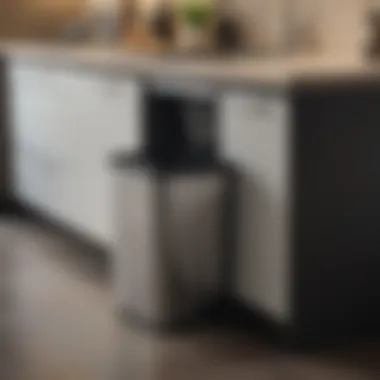
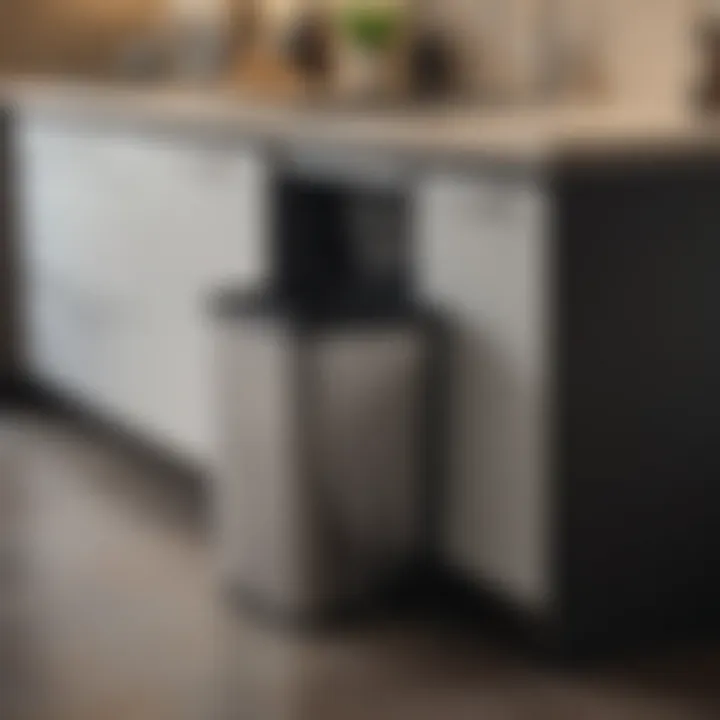
Intro
Under-counter trash cans are more than just functional kitchen elements; they embody a blend of efficiency, design, and convenience. As homeowners seek to maximize their space while maintaining aesthetics, the choice of a trash can can significantly impact the overall appeal of a kitchen. This guide aims to dissect various aspects of under-counter trash cans, from unique design inspirations to practical maintenance tips, helping readers make informed decisions.
Understanding how to select the right under-counter trash can involves examining different styles and materials. Additionally, it is essential to consider installation aspects and how they fit into the kitchen layout. This guide will cover these areas in detail, leading to a comprehensive understanding of the topic.
Understanding Under-Counter Trash Cans
Under-counter trash cans have gained traction as a favored solution in modern kitchen design. Their importance stems from providing a space-efficient answer to waste management, particularly in homes with limited space. These systems not only declutter the kitchen but also optimize the arrangement of other necessary kitchen items. Furthermore, the variety of styles ensures that they seamlessly fit into various decor preferences.
The primary purpose of these trash cans goes beyond holding waste. They offer a discreet way to contain refuse, thus preventing odors from permeating the kitchen space. Understanding their functionality is crucial for homeowners and design enthusiasts who aim to enhance their living areas.
Definition and Purpose
An under-counter trash can is defined as a waste collection bin designed to be placed beneath a countertop or within a cabinet. The main purpose of these units is to facilitate easy disposal of waste while keeping it out of sight, effectively maintaining an organized and clean environment. They come in various forms, such as pull-out or tilt-out models, each with specific features that add convenience to their functionality.
Benefits of Under-Counter Trash Cans
Space Efficiency
Space efficiency refers to the effective use of available area. Under-counter trash cans exemplify this principle, fitting neatly into unused cabinet space or beneath countertops. This design effectively minimizes the visual clutter often associated with traditional trash bins. By integrating these trash cans into cabinetry, homeowners can use their kitchen space more fully. This results in a clean atmosphere and more usable counter space for food preparation or decoration.
Enhanced Aesthetics
Enhanced aesthetics highlights the visual benefits of using under-counter trash cans. Instead of an unattractive free-standing bin, an integrated design maintains a streamlined look. This characteristic is preferable for homeowners who want their kitchens to appear tidy and harmonious. The concealment of the trash can contributes to an overall polished appearance of the cooking area, allowing for a seamless blend with other kitchen elements.
Improved Accessibility
Improved accessibility focuses on the ease of waste disposal offered by under-counter solutions. With designs that allow for smooth sliding or tilting, users can quickly reach the trash can without the hassle of lifting or moving bulky bins. This feature is particularly important in busy kitchens where time efficiency is paramount. The convenience of access supports better hygiene practices, as waste can be disposed of swiftly, minimizing any contact with surfaces.
Types of Under-Counter Trash Cans
Understanding the different types of under-counter trash cans is essential for making an informed choice. Each style serves a unique purpose, presenting specific benefits and challenges. By recognizing the various options available, homeowners can select a model that maximizes functionality and fits seamlessly into their kitchen or designated space.
Pull-Out Trash Cans
Pull-out trash cans are designed to slide in and out of cabinets, offering easy access while maintaining a sleek appearance. This style is valued for its practicality. When a homeowner needs to dispose of waste, all they do is pull the can out, making waste disposal quick and efficient.
One significant advantage of pull-out trash cans is their ability to conserve space. Installed within the cabinetry, these cans do not take up floor space and can accommodate larger volumes of waste without being visible. Installation involves simple hardware that allows the bin to glide in and out smoothly.
However, careful consideration of the cabinet's alignment is needed. If space is limited, the dimensions of the pull-out trash can must be compatible with the cabinet. Additionally, ongoing maintenance is required to keep the gliding mechanism clean and operational. Despite these small challenges, the convenience and space efficiency make them a popular choice for many households.
Tilt-Out Trash Cans
Tilt-out trash cans are uniquely designed with a front-facing tilt feature. This style of can is attached within a cabinet door, allowing users to simply tilt the can open without needing to physically pull it out. This can contribute to a more organized kitchen, as the waste container is hidden behind a decorative facade.
The tilt-out mechanism is particularly user-friendly. It enables disposal of waste with minimal movement, making it suitable for those with mobility challenges. It also targets odor control as the lid can contain smells better when closed.
Nevertheless, the installation of a tilt-out can may require additional cabinet modifications, particularly if you want to maintain a consistent look with existing cabinetry. Compatibility with the kitchen layout should be considered as well, to ensure that necessary space is available. Despite these requirements, this option enhances accessibility and ensures an aesthetically pleasing environment.
Built-In Trash Cans
Built-in trash cans take custom cabinetry to the next level. These models are integrated into kitchen cabinets, often concealed behind doors or designated panels. This feature promotes a seamless design, making the waste disposal mechanism virtually invisible. This approach to waste management caters to those with a commitment to achieving a polished, clutter-free look in their kitchens.
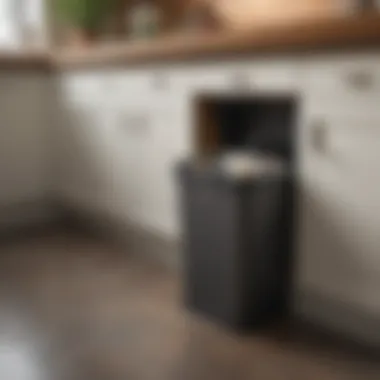

Such cans can be designed to fit various sizes and styles of kitchen cabinets. They can also accommodate various configurations, allowing for more than one waste compartment. This characteristic can be beneficial for those looking to recycle or separate waste. Furthermore, they tend to be made from sturdier materials, enhancing their longevity.
However, the installation process for built-in options can be more complicated and potentially costly. This style may require professional assistance to ensure proper fit and function. While they can represent a larger upfront investment, their aesthetic appeal and durability might make them a worthwhile addition for homeowners focusing on cohesive kitchen design.
"Select an under-counter trash can that not only meets your waste management needs but also aligns with your aesthetic preferences. Choosing the right design contributes to a more functional living space."
In summary, understanding the types of under-counter trash cans ensures that homeowners can make decisions that suit their specific needs. Pull-out, tilt-out, and built-in styles all have their unique pros and cons. By weighing these factors carefully, homeowners will find an under-counter trash can that complements their space and lifestyle.
Key Considerations in Selection
When selecting an under-counter trash can, several factors must be taken into account. These considerations can significantly impact the functionality and aesthetic of your kitchen. Making informed decisions in this phase is critical to ensure the setup meets both practical needs and design preferences.
Size and Capacity
The first aspect to consider is size and capacity. Under-counter trash cans come in various sizes, and choosing the right one depends mainly on your household's waste generation. If you have a large family, a trash can with higher capacity will prevent frequent bag changes while optimizing your kitchen workflow. Conversely, for smaller households, compact options may suffice without sacrificing valuable under-counter space. Measuring the designated area carefully is crucial to ensure that the can fits comfortably without obstructing other kitchen functionalities.
Material Choices
Plastic vs. Metal
The choice between plastic and metal is essential in determining the trash can's durability and maintenance requirements. Plastic trash cans are typically lighter and often less expensive. They can be easy to clean but may become brittle over time, especially in extreme temperatures. In contrast, metal cans are usually sturdier, provide a more modern look, and tend to have better odor control features. However, they can rust if not properly coated or if exposed to moisture frequently. The choice between these materials should align with the intended use, overall design, and personal preference.
Recycled Materials
Using recycled materials is another consideration that adds an eco-friendly dimension to your selection process. Recycled trash cans are often made from post-consumer products, reducing the carbon footprint associated with new material production. This choice can appeal to environmentally-conscious consumers. However, it is important to note that while many recycled products are durable, some may have limitations regarding aesthetics or performance compared to traditional materials. Choosing recycled models can contribute positively to waste management practices.
Design and Finish
Modern Styles
The aesthetic appeal of under-counter trash cans cannot be overlooked. Modern styles often feature sleek lines and innovative designs that can blend seamlessly with contemporary kitchen decor. These designs may also incorporate features such as touch-free openings or integrated odor control technologies. A modern trash can sometimes acts as a subtle statement piece in your kitchen rather than just a utilitarian item.
Traditional Options
Traditional options are equally relevant for many homeowners. They provide a classic look, often made from wood or metal designed to match vintage or farmhouse-style kitchens. These models can bring warmth and familiarity to the space. However, while they can be visually appealing, it’s important to consider their functionality and how they might fit into more modern kitchen layouts.
Installation Approaches
Understanding installation approaches for under-counter trash cans is crucial. This section delves into the methods available, providing essential insights and considerations. Choosing the right installation method can significantly affect the functionality, efficiency, and overall appeal of the space. It ensures that the trash can integrates seamlessly into your kitchen or utility area, allowing easy access while promoting a tidy environment.
DIY Installation
DIY installation of under-counter trash cans offers several advantages. First, it can save money that would otherwise go to hiring professionals. Second, it allows homeowners to have complete control over the process. You can customize the installation to fit your specific needs and preferences.
Here are some steps to consider for a successful DIY installation:
- Measure the Space: Start by measuring the area where the trash can will go. Ensure the dimensions align with the model you choose.
- Choose the Right Model: Depending on the space, pick a model that complements the kitchen style and meets your needs.
- Gather Tools: Basic tools such as a screwdriver, level, and possibly a power drill will be necessary.
- Follow Instructions: Most trash can models come with installation guides. Adhering to these instructions will ensure proper setup. Be sure to account for any unique kitchen features, such as cabinets and plumbing.
- Test Functionality: Once installed, test it to ensure it operates smoothly. Make adjustments if necessary.
While DIY can be rewarding, it is essential to be mindful of your skill level. If the task feels overwhelming, seeking help may be wise.
Professional Installation Services
For those who prefer a hassle-free approach, professional installation services provide a reliable solution. These services ensure that the installation is performed correctly, saving time and reducing the risk of mistakes. Hiring professionals can be especially beneficial for more complex setups or in older homes where layouts may not conform to standard measurements.
Consider the following advantages of professional installation:


- Expertise and Experience: Professionals are familiar with various models and installation techniques. Their experience can expedite the process.
- Guaranteed Quality: With trained technicians, there is a higher likelihood of precision and accuracy, leading to a better finished product.
- Time Efficiency: Hiring professionals can save valuable time, allowing you to focus on other aspects of home improvement.
When selecting a service, it is advisable to compare options, read reviews, and verify credentials to ensure you find a reputable provider.
Remember: Proper installation enhances the longevity and functionality of your under-counter trash can. Whether opting for DIY or professional installation, making an informed choice contributes to a more efficient living environment.
Maintenance and Care
Proper maintenance and care of under-counter trash cans is essential for their longevity and effectiveness. These cans play a vital role in keeping kitchens organized and hygienic. Regularly maintaining these units can prevent unpleasant odors, prolong their lifespan, and ensure they remain looking appealing. Below, we discuss cleaning guidelines and methods to maintain odor control, both of which are critical for optimal performance.
Cleaning Guidelines
Cleaning under-counter trash cans should be a routine task. This ensures that remnants of waste do not linger, which could lead to hygiene issues. Here are several key cleaning steps to consider:
- Frequency: Aim to clean your under-counter trash can at least once a week. More frequent cleaning may be necessary, especially for cans that handle food waste.
- Materials: Use mild dish soap mixed with warm water. Avoid harsh chemicals, as they can damage certain materials used in the trash cans.
- Procedure: Remove the inner bucket if available. Wash it separately with soap and water. Wipe down the exterior with a damp cloth and soap. Be sure to get into the corners.
- Drying: Allow all components to air dry completely before reinstalling. Moisture can promote mold growth.
By following these cleaning guidelines, homeowners can maintain not only the structural integrity of the trash can but also the cleanliness of their kitchen environment.
Maintaining Odor Control
Odors can be a significant issue when it comes to waste management in kitchens. Implementing strategies for odor control is necessary to create a comfortable living space. Here are some effective approaches:
- Use of Liners: Employing high-quality trash liners can trap odors and make it easier to clean your trash can. While plastic bags are common, opting for biodegradable liners may also offer enhanced odor control.
- Regular Emptying: Make it a habit to empty the trash can regularly. The less waste accumulated, the lower the chance of unpleasant smells developing.
- Natural Deodorizers: Consider using natural deodorizers such as baking soda inside the can. It can absorb odors effectively without adding harmful chemicals to your environment.
- Ventilation: Ensure proper airflow around the trash can. Adequate ventilation can reduce smell buildup. If possible, place your can in an area that allows for airflow.
By executing these simple tasks, you can effectively maintain odor control in your under-counter trash cans.
Remember, a clean and odor-free trash can contributes significantly to maintaining a pleasant kitchen atmosphere.
Cost Implications
Understanding the cost implications of under-counter trash cans is essential for homeowners looking to optimize their spaces without overspending. Various factors impact the pricing of these units, including size, materials, and design features. Carefully considering these aspects can help discern what offers the best value for money while meeting practical needs. A better grasp of pricing can assist buyers in making informed decisions that blend functionality and cost-efficiency in their kitchens.
Price Range Overview
The price range for under-counter trash cans can vary significantly based on multiple criteria. On average, homeowners can expect to spend between $50 and $500 on these units. More specific pricing can be broken into the following brackets:
- Basic Models: Typically costing from $50 to $150, these trash cans offer essential features and are often made from plastic or less durable materials.
- Mid-Range Options: Priced between $150 and $300, this range often overlaps modern design elements with durable materials such as metal or high-grade plastic.
- Premium Designs: Models over $300 tend to offer advanced features such as automatic lids, specialized odor control, and enhanced materials. Many of these models incorporate design elements that complement upscale kitchen decor.
Factors Influencing Cost
Several factors affect the pricing of under-counter trash cans, which include brand reputation and the balance between material and design choices.
Brand Reputation
Brand reputation plays a crucial role in determining the cost of under-counter trash cans. Renowned brands like simplehuman and Rev-A-Shelf often charge a premium for their products. This reputation stems from consistent product quality and customer satisfaction. A key characteristic of these brands is their focus on ergonomic design and long-lasting materials. Choosing a well-regarded brand can sometimes justify higher costs because of the potential for better durability and customer service.
Additionally, established brands often feature unique features such as quiet-close mechanisms and premium finishes that can enhance functionality. While the price may be higher, investing in a recognized name can provide peace of mind and often, a warranty that cheaper alternatives lack.
Material vs. Design
The choice between material and design significantly influences the cost of under-counter trash cans. High-quality materials like stainless steel or thick plastic come at a higher price point than lower grade alternatives. A noteworthy characteristic here is durability; more expensive materials tend to last longer, thus offering long-term savings.
On the design front, unique configurations may also drive up costs. For example, tilt-out designs often require more intricate construction and can be pricier than standard pull-out units. Ultimately, balancing materials with design preferences can significantly affect overall spending. Prioritizing durability while also considering aesthetic aspects can ensure that homeowners make a savvy investment.
"Ultimately, the goal is achieving a balance between quality, style, and budget – guiding users towards optimal purchasing decisions."
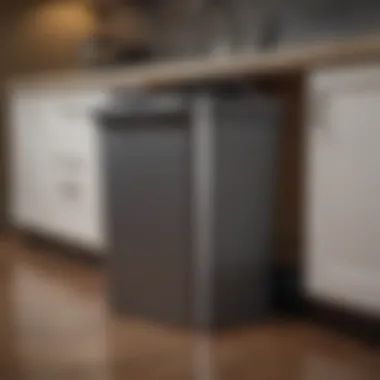
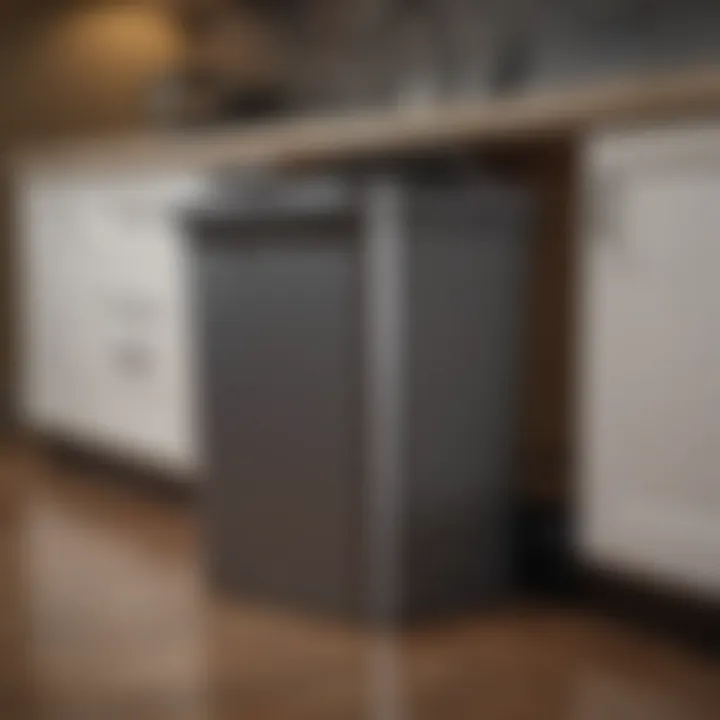
Considering these factors will aid in understanding the cost spectrum associated with under-counter trash cans, ensuring that choices are aligned with functional and aesthetic preferences.
Sustainability Considerations
Sustainability has become an essential element in design and home improvement. When it comes to under-counter trash cans, understanding sustainability can guide homeowners in selecting options that not only serve a functional purpose but also minimize environmental impact. Eco-conscious choices lead to more responsible waste management, which is not only beneficial for the planet but also aligns with the growing preference for sustainable living.
Eco-Friendly Materials
The choice of materials in under-counter trash cans plays a significant role in sustainability. Opting for eco-friendly materials can reduce the carbon footprint associated with the production and disposal of these items. Materials such as recycled plastics and metals are preferable. These options not only use fewer resources but also support the recycling industry.
- Recycled Plastic: This type of plastic helps divert waste from landfills. It’s durable and can withstand the usual wear and tear found in kitchen environments.
- Metal Options: Metal trash cans, particularly those made from recycled aluminum, offer long-lasting quality. They are often more easily recyclable than plastics.
- Biodegradable Materials: Some brands offer compostable lining or bags that break down naturally, further promoting eco-friendly practices.
Using eco-friendly materials not only enhances the aesthetic appeal of the trash can but also communicates a commitment to sustainability. It is essential to check product labels and certifications to ensure that the materials are genuinely eco-friendly.
Waste Management Practices
Understanding waste management practices is crucial when it comes to implementing sustainable under-counter trash cans. Effective waste management can significantly reduce the amount of waste sent to landfills. Here are some practices to consider:
- Separation of Waste: Under-counter trash cans can be compartmentalized for recycling, compost, and trash. This system encourages proper waste separation and makes recycling easier.
- Use of Composting: For households that can compost, having a separate bin within the under-counter area dedicated to organic waste can help in reducing landfill waste.
- Regular Maintenance: Maintaining the cleanliness of the trash area can promote hygiene and reduce unpleasant odors, making it easier to manage waste efficiently.
Implementing effective waste management practices ensures that under-counter trash cans do not merely hold waste but contribute to a more sustainable lifestyle.
By selecting eco-friendly materials and incorporating sound waste management strategies, homeowners can play a role in environmental preservation through their choice of under-counter trash cans.
Popular Brands and Models
Understanding popular brands and their models in the realm of under-counter trash cans is invaluable for consumers. This section highlights the alignment of quality with functionality. When homeowners and design enthusiasts consider an under-counter option, brand reputation often mirrors performance. The right choice not only affects aesthetic appeal but also durability and ease of use. Recognizing leading brands helps streamline decision-making during the purchasing process.
Overview of Leading Brands
Among the brands that consistently gain attention, innovative companies like Rev-A-Shelf, Simplehuman, and Knape & Vogt stand out. Each has carved out a niche by offering unique products and designs, ensuring consumers find solutions that meet their individual needs.
- Rev-A-Shelf is known for its impressive range of pull-out systems that enhance the kitchen’s efficiency while maximizing space.
- Simplehuman emphasizes practicality with their trash cans designed for ease of use, focusing on hands-free operation in many models.
- Knape & Vogt provides a variety of durable choices, focusing on design versatility that can fit in modern and traditional kitchens alike.
These brands maintain a reputation by balancing style, innovative features, and customer support. This balance aids in purchasing confidence amongst consumers.
Model Comparisons
When comparing models from these respected brands, several factors need consideration:
- Capacity: Different models cater to varied household sizes. Simplehuman offers models that handle smaller volumes suitable for compact living spaces, while Rev-A-Shelf has larger options designed for families.
- Material: The construction materials can significantly impact a product's longevity. Metal options tend to be more durable compared to plastic, although plastic models may offer better flexibility and lighter weight.
- Design Features: Some models provide built-in odor control, while others might include a soft-close feature to minimize noise.
This comparison enables homeowners to align their specific needs, preferences, and budgets with the right model.
"Choosing the best under-counter trash can depends heavily on understanding what each brand and model offers in terms of functionality and style."
Ending and Recommendations
Understanding under-counter trash cans is crucial to maximizing space and functionality in kitchen designs. Their thoughtful integration can significantly enhance the efficiency and tidiness of any area. This section synthesizes the insights covered in the article, offering guidance that will assist homeowners and design enthusiasts alike in making informed decisions.
Summary of Key Points
- Definition and Purpose: Under-counter trash cans serve to cleverly conceal waste disposal areas, maintaining a clean and organized appearance in kitchens or utility spaces.
- Benefits: Space efficiency, pleasing aesthetics, and improving accessibility are primary advantages. They allow for better kitchen flow without compromising on cleanliness or visual appeal.
- Types: This guide discussed various designs such as pull-out, tilt-out, and built-in trash cans, each offering unique features suited to different needs.
- Key Considerations: Size, material options, and design styles were evaluated as vital factors in selecting the right trash can for one's space.
- Installation: Both DIY methods and professional services were highlighted, reflecting the assorted skills homeowners may possess.
- Costs and Sustainability: A focus on the investment value, factors affecting pricing, and eco-friendly materials underline the importance of responsible purchasing.
- Popular Brands: Insight into leading brands and their models offers practical examples for potential buyers.
Final Recommendations
When choosing an under-counter trash can, it is advised to prioritize functionality alongside aesthetics. Begin by evaluating the size of the designated space and considering the capacity needed for your household. Evaluate materials; if sustainability is a priority, seek options featuring recycled components.
Moreover, install a model that complements your kitchen's design narrative. Aesthetics and practicality must coexist; thus, select a product that appeals to you visually while offering seamless usability. Consider brands renowned for product quality, such as simplehuman or Rev-A-Shelf, as these often represent reliability in function and durability.
Ultimately, under-counter trash cans are foundational elements in efficient home designs. Their thoughtful placement contributes to a cohesive environment, lowering clutter and facilitating waste management. By reflecting on the insights presented in this guide, readers can navigate their choices confidently, elevating both their kitchen's efficiency and overall appeal.















